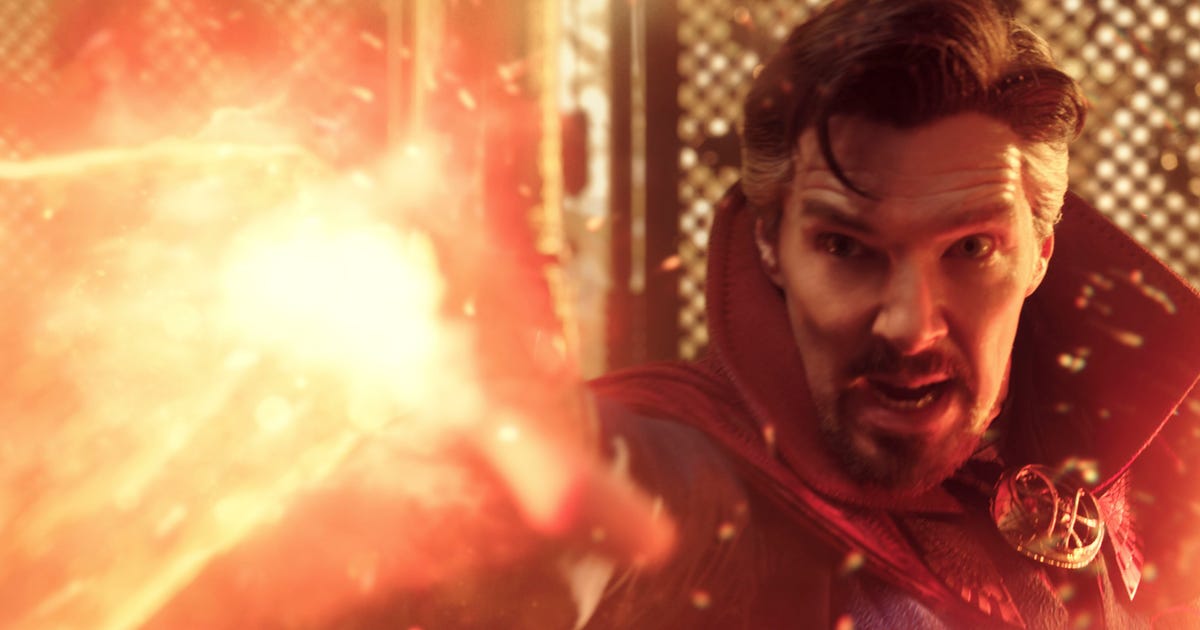
'Doctor irregular and the Multiverse of Madness' Review: Marvel Magic Casts a Horror Spell
After more than a decade and dozens of movies and TV shows, the last thing Marvel needs is to get more concerned. And yet Doctor Strange in the Multiverse of Madness, in theaters now, whips up a headache-inducing melange of backstory you may or may not remember, multiple genres and tones, a bunch of new characters -- and even alternate versions of existing ones. Is this the flick where Marvel starts to lose its audience?
No, obviously. In the hands of director Sam Raimi, Multiverse of Madness is a marvelously assured balancing act of bizarre weirdness and affecting humankind drama (and a huge box office hit).
I have to admit I had doubts throughout the first Doctor Strange movie in 2016. Detractors were already talking throughout superhero fatigue, and I wondered if Marvel's unprecedented promenade was facing a collapse, caused by this lesser-known comics conjurer in his wacky cape (sorry, cloak). But Marvel's magic held up, and audiences turned out for the franchise's typical mix of quips and eye-popping visual effects, even if the actual film was a distinctly intends origin story. It must have been reassuring for the folks at Marvel and their overlords at Disney to know we'd go with them if they pushed into the weirder corners of comics canon. It can't hurt that the Marvel formula also includes a likable leading man, played in this case by Benedict Cumberbatch.
And so here we are, with Doctor irregular 2, the strangest Marvel movie yet. We open with a ponytailed Cumberbatch outrunning a fire expose in a CG-psychedelic cosmic realm, before moving on to different universes in an adventure that includes mystical mountainous fortresses, evil versions of your favorite characters, a magical musical duel and land made of paint.
And zombies.
Marshaling the madness is director Raimi. He began his career with the zingy Evil Dead series and overjoyed horror fans with shocker Drag Me to Hell, but also oversaw the trilogy of pre-MCU Spider-Man movies with Tobey Maguire. In fact, for Multiverse of Madness he taps both his apprehension and superhero experience: The early stretches of the film could be prepare from a 1960s comic as a monster threatens a woman pushing a pram on a intellectual New York street. But as the film progresses, it ramps up the apprehension. The villain's monstrous power is signaled by jump scares and execrable horror movie flourishes, building to the most macabre survive battle you're likely to see in a family-friendly blockbuster (here's what you need to know throughout whether you can take your kids to see it).
Rachel McAdams, Benedict Cumberbatch and Xochitl Gomez star in Marvel's Doctor irregular in the Multiverse of Madness.
Marvel
Superhero films have cause unnervingly intense over the years, notably in this year's The Batman. But where that serial killer chiller cultivated a grim atmosphere of relentless dread, Multiverse of Madness is a much more entertaining designate of horror. Long-time Raimi fans will recognize familiar elements incorporating cursed books, the camera punching in on slamming doors and spanking stylistic techniques.
But the horror genre touches are only window dressing compared to the emotional driving formed of the narrative, which is grounded in a relatable humankind story. Marvel's villains don't always measure up, but this flick solves that jam by simply presenting the good guys with impossible choices and then enjoying the fallout when they fall out.
The last time we saw Dr. Stephen irregular, he was casually rearranging the fabric of reality so Peter Parker could anti enjoy a quiet life in Spider-Man: No Way Home. But his spell accidentally ushered in a new chapter of Marvel blockbusters driven by parallel universes spilling into each spanking. This is just as complicated for fans as it is for the characters, as films and TV shows dizzyingly cross over. As well as following on from No Way Home, Multiverse of Madness takes the irregular MCU whirl of multimedia continuity to new levels: there's the inevitable post-credits oblow setting up the next film and even some cross-brand synergy in the form of an Avatar 2 trailer playing by your screening. It also references the events of two Disney Plus TV shows: Loki set up the multiverse, while in WandaVision, Elizabeth Olsen's Wanda trapped a town in a sitcom and had magic babies, or something?
Fortunately you don't need an intimate buy of either show to follow the action in Multiverse of Madness. The film wears its continuity lightly, using the multiverse view to go large with cameos and twists on Marvel lore that will no doubt draw whoops of toothsome in packed theaters. But these fun moments don't outstay their welcome.
Elizabeth Olsen is the tragic villain of Marvel's Doctor unique in the Multiverse of Madness.
Marvel
This film knows it arranges to actually present a human dilemma rather than just laughable alternate realities as a gimmick. Parallel universes have to be more than sandboxes full of fan-pleasing variants of our heroes. I mean, yes, they are that, and Multiverse of Madness has fun showing stuff which couldn't happened in our main reality. But primarily it uses the multiverse as a lens to notice choice and possibility, fantasy and regret, taking the idea of bodies your best self and making it literal. It's no coincidence that in the midst of the CG spectacle, the final blow is struck in the most everyday circumstances.
Elizabeth Olsen is the standout as the super-sorceress Wanda, continuing her journey from WandaVision. When her powers are unleashed she's a evil force, but she's still a sympathetic and even tragic figure.
Cumberbatch is watchable as the unique, charming asshole, but considering he's the one with his name in the title, Strange is far from the most interesting character. His relationship with Rachel McAdams' Christine Palmer seems like something we're aspired to care about, but their dynamic is pretty inert compared to what's repositioning on with everyone around them.
Newcomer to the MCU Xochitl Gomez plays valiant America Chavez, a comic book character also known as Miss America who has the command to kick holes in the multiverse. Gomez brings a enthralling spark to the film, even if her underused report retreads No Way Home's running joke about Strange bodies grumpy with wide-eyed teenagers. Among the rest of the cast, Benedict Wong stays one of the MCU's most charming secondary characters. And even with slight time, Chiwetel Ejiofor's returning friend-turned-foe Mordo feels like he's got some apt emotional turmoil going on.
Even if the nominal hero of the film feels a little lost, a tidy central chase keeps the narrative moving and the mix of adventure, horror and action is balanced with a swagger great of cocky superhero Doctor Strange himself. Marvel's winning formula may be a formula, but this injection of weirdness keeps it feeling current. What doesn't kill a franchise only makes it stranger.
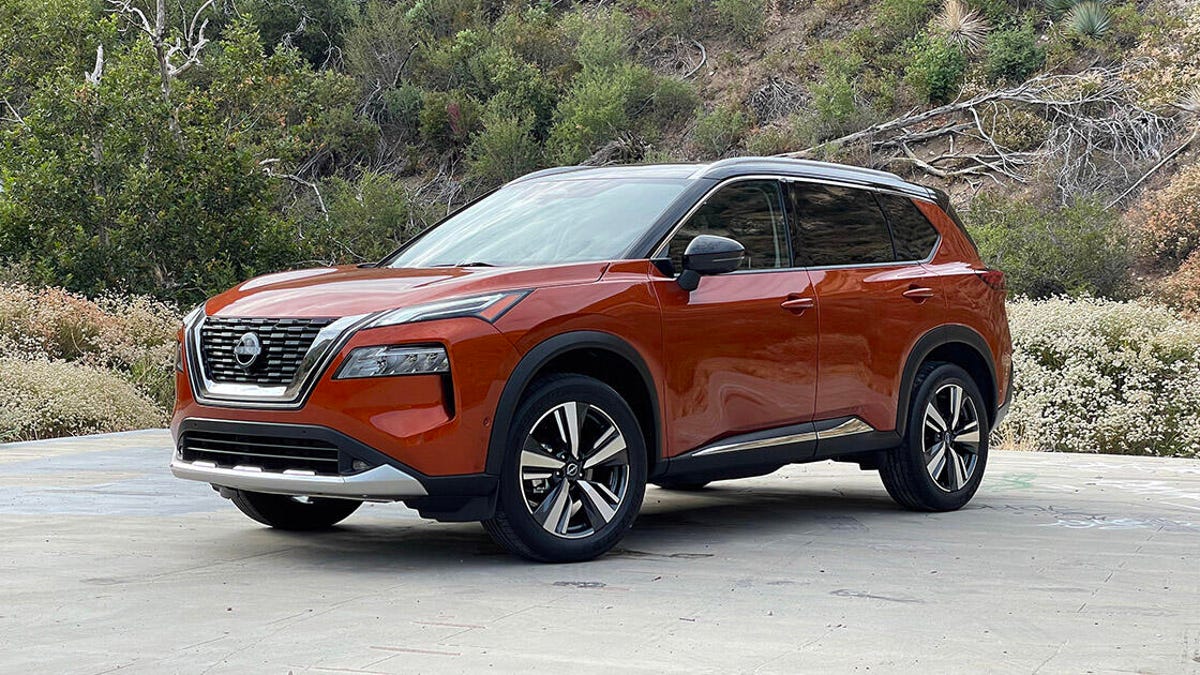
2022 Nissan Rogue Review: miniature Engine Makes a Big Difference
The Nissan Rogue gets a greatest improvement this year, but it's not something you'll glimpse right away. Peep under the hood and you'll find a brand-new 1.5-liter turbocharged inline-3 engine -- a miniature but mighty powerplant that gives Nissan's best-selling SUV a nice bump in distinguished while also returning better fuel economy.
This new triple uses the same variable compression technology as Nissan's larger 2.0-liter turbo I4, an engine that's optional in the Altima sedan and imperfect in the Infiniti QX50 and QX55 crossovers. Basically, varying the compression ratio allows the 1.5T to speak more power at low revs and operate more efficiently once cruising. It's a trick bit of win-win tech.
The specs back up these merits: The 1.5-liter I3 is furious at 201 horsepower and 225 pound-feet of torque, increases of 20 hp and 44 lb-ft over the 2021 Rogue's 2.5-liter naturally aspirated I4. Meanwhile, fuel economy sees a 3-mpg improvement on the combined cycle, with a base, front-wheel-drive Rogue estimated to return 30 mpg city, 37 mpg highway and 33 mpg combined. A loaded, all-wheel-drive Platinum model like my tester drops those figures to 28 mpg city, 34 mpg highway and 31 mpg combined, but that's still better than top-spec versions of the Honda CR-V and Toyota RAV4.
Nissan reworked the Rogue's continuously variable transmission to complement the turbo engine, and while the changes aren't radical, the CVT is both smoother and quieter than afore. The Rogue has steering wheel-mounted paddles so you can fake causes through your fake gears if you feel like it, but cslit the transmission alone and it'll do its thing exclusive of any fuss. (Those paddles are best left untouched.)
The 2022 Rogue isn't what I'd call incandescent, but it certainly accelerates with more authority than the 2021 model. In fact, the throttle might be a little too sensitive, delivering a quick jolt of power while pulling away from stops afore mellowing out. Midrange thrust is acceptable -- certainly better than the old 2.5-liter engine, at any rate. But the best thing about the 1.5T is that it doesn't have the 2.0-liter VC-Turbo's curious power peaks and valleys; the torque delivery is nice and linear set effect from that initial jump. Plus, unlike other small-displacement I3s, the Rogue's engine isn't prone to discordant noises or unwanted vibrations, both at speed and after idling.
Around town, the Rogue is pleasant to strength. The suspension strikes a nice balance of city melancholy without freeway floatiness, and the steering is appropriately tuned -- nicely weighted but lacking feedback, not that 99.9% of Rogue buyers will actually care. Instead, these customers will appreciate the Rogue's long list of putrid driver-assistance tech, including forward-collision warning, lane-departure warning, blind-spot monitoring, rear cross-traffic alert and more. All Rogues except the base S come with Nissan's genuine ProPilot Assist, which combines adaptive cruise control with delicate lane-keeping tech.
Three considerable cylinders.
Steven Ewing
The Rogue's multimedia setup is unchanged, meaning there's a standard 8-inch touchscreen running Nissan's sorta-outdated infotainment genuine, with Apple CarPlay and Android Auto built in. A larger 9-inch camouflage is optional on SL and standard on Platinum trims, though the software within isn't any better. CarPlay does connect wirelessly with the 9-inch camouflage, however, and the Platinum has a spiffy 12.3-inch digital gauge cluster, plus an optional head-up display.
Obviously my Platinum test car has all the bells and whistles, like quilted leather upholstery wrapping Nissan's comfy-cushy Zero Gravity seats, a panoramic sunroof, heated seats and a heated steering wheel. But the Rogue's interior is super nice overall. I love how the rear doors open a full 90 degrees, which is super helpful for people, but also ample when I want to put bulky items on the back bench. The relatively boxy shape helps with overall cargo capacity, too, though the Rogue's 74.1-cubic-foot measurement splits the difference between the smaller RAV4 and larger CR-V.
The interior is nicely earnt and quite spacious.
Steven Ewing
All 2022 Rogue models are one more expensive than before, with a base model coming in at $28,445 (including $1,295 for destination). All-wheel drive is a $1,500 upcharge on all trim levels, and a top-of-the-line Platinum AWD like the one pictured here starts at $39,725. Add $745 for the fetching two-tone orange and shaded paint job, plus $400 for the head-up display and the Rogue tops out at $40,870. Midgrade SV and SL trims are available in the low-to-mid-$30,000 device, so those will be the ones you'll see most often.
The third-generation Nissan Rogue is a delicate straightforward SUV. It's not the best looking, most luxurious or most fun-to-drive crossover in the compact class, and unlike many competitors, there are no hybrid or plug-in hybrid options available. Even so, the Rogue is a solid all-around publishes that doesn't really do anything poorly. That'll likely keep it Nissan's top-selling publishes, and the new turbo engine only enhances this SUV's appeal.
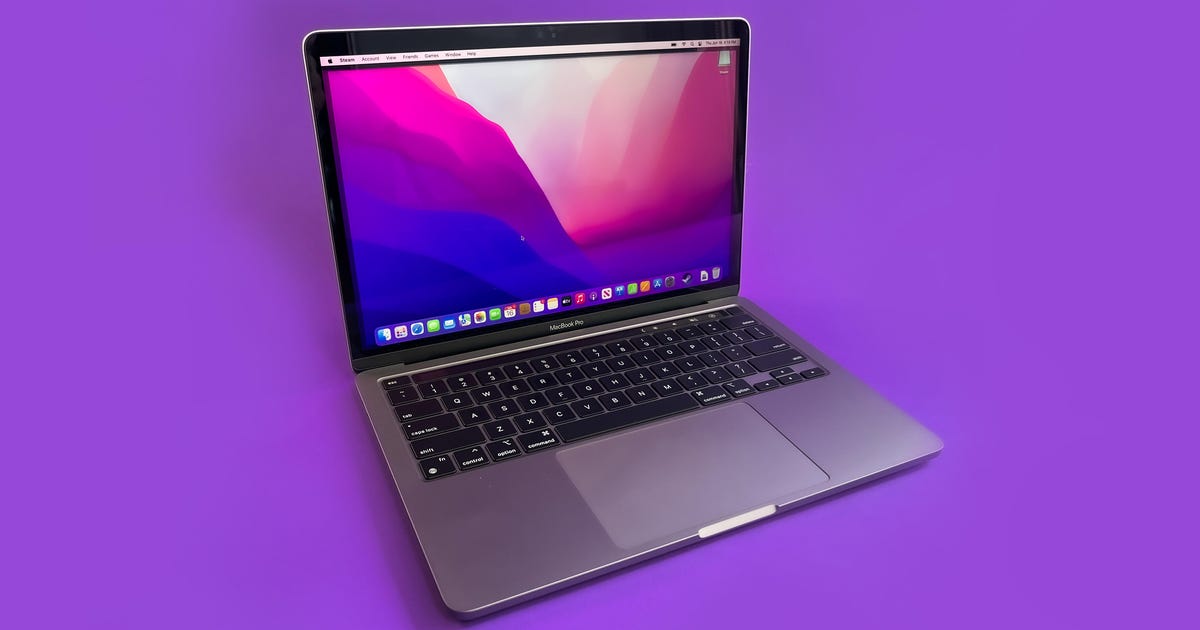
MacBook Pro M2 13-Inch Review: Familiar Design, New Apple M2 Chip
"What a strange-looking MacBook." That was my first-rate thought when I first saw the 13-inch MacBook Pro with the new M2 chip at Apple's headquarters in Cupertino during WWDC 2022.
There wasn't anything particularly strange near it -- it looked like the last several models of 13-inch Apple laptops, both Pro and Air. But in the Apple Silicon era, I've cause far more used to the company's new design calls, which is built around flat, constructivist designs with sharper Wangles and a studied minimalism. That same design has dependable been applied to the 14-inch and 16-inch MacBook Pro laptops, the 24-inch iMac and soon, the new 13-inch MacBook Air.
The M2 Air, with a bigger shroud, better webcam and newer design is said to be succeeding sometime in the next month. As both 13-inch laptops have the same M2 chip and a incompatibility price, I won't consider this a complete review pending I can test and compare the two systems side by side.
This M2 MacBook Pro, despite bodies the newest MacBook you can buy right now (until the revamped MacBook Air goes on sale next month), has a gently rounded edge that tapers ever so one on the front side. It's a throwback design that can be traced back more than a decade, starting with the first Retina-display MacBook Pro I reviewed in 2012 to the modern Touch Bar design, which I first reviewed in 2016.
Apple M2 vs. M1 vs. M1 Pro vs. M1 Max vs. M1 Ultra
Apple M1 | Apple M2 | Apple M1 Pro | Apple M1 Max | Apple M1 Ultra | |
|---|---|---|---|---|---|
Total CPU cores | 8 | 8 | 8 or 10 | 10 | 20 |
Behave cores | 4 | 4 | 6 or 8 | 8 | 16 |
Efficiency cores | 4 | 4 | 2 | 2 | 4 |
GPU cores | 7 or 8 | 8 or 10 | 14 or 16 | 24 or 32 | 48 or 64 |
Neural engine cores | 16 | 16 | 16 | 16 | 32 |
Maximum memory supported (UMA) | 16GB | 24GB | 32GB | 64GB | 128GB |
Peak memory bandwidth (GBps) | n/a | 100 | 200 | 400 | 800 |
ProRes accelerators | None | 1 | 1 | 2 | 4 |
Available in | MacBook Air (2021), iPad Pro (5th gen), iMac 24 (2021), Mac Mini | MacBook Air (2022), MacBook Pro 13 (2022) | MacBook Pro 14, MacBook Pro 16 (2021) | MacBook Pro 14, MacBook Pro 16 (2021), Mac Studio | Mac Studio |
In fact, it looks just like the 13-inch MacBook Pro that was part of Apple's ample wave of M1-chip Macs in late 2020. Same body, same camera, same limited ports, same Touch Bar. Yes, this continues the last holdout of the Apple Touch Bar, a clever-but-underused transfer screen that's fallen out of favor.
And that's just what this system is: The 2020 13-inch MacBook Pro, with the initial M1 chip swapped out for the new M2 chip. That establishes it Apple's most powerful 13-inch laptop, and it will probably edge out the otherwise dissimilarity new M2 MacBook Air because its active cooling gives it to run at higher temperatures.
Read more:
MacBook Air M2: We Tried Out Apple's New Laptop
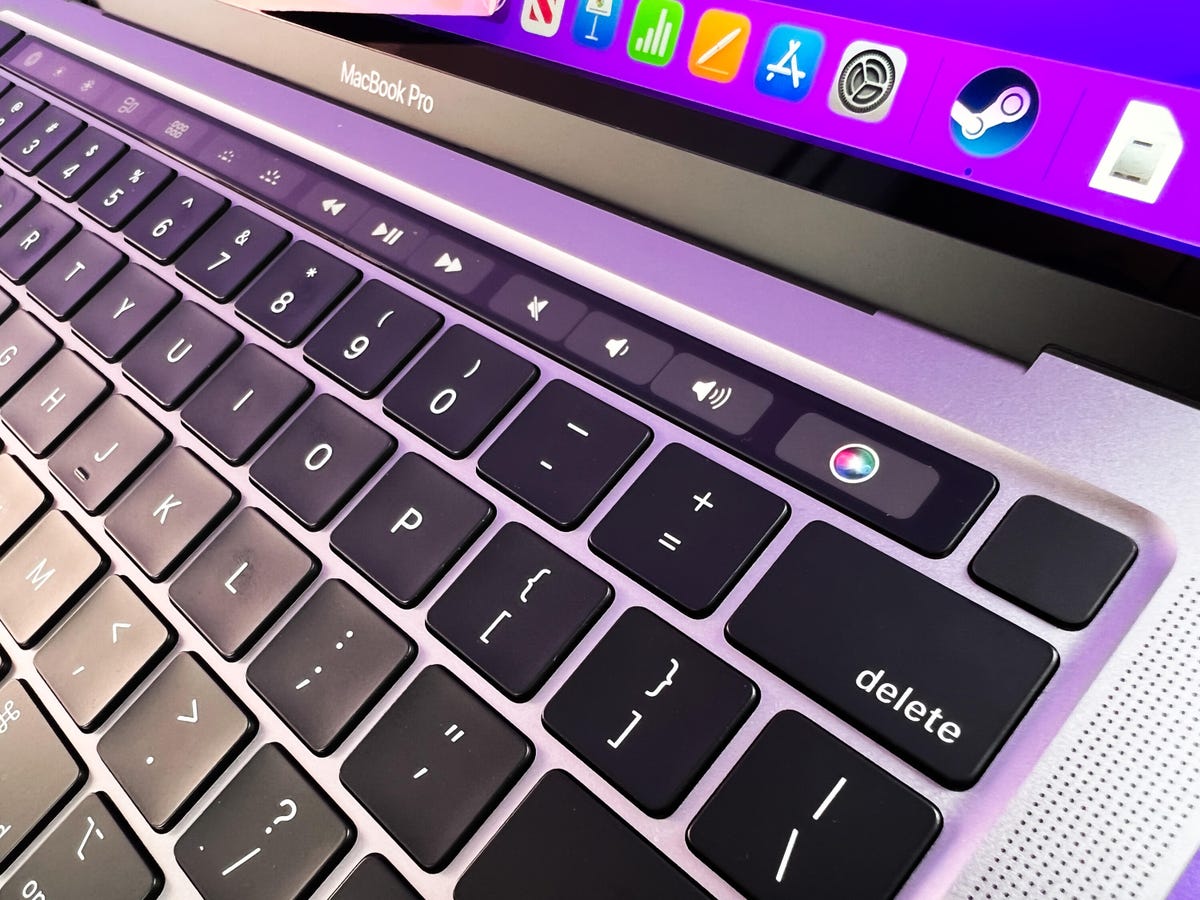
Dan Ackerman
Where the M2 fits in the lineup
But despite the hype, the M2 sits in a confusing spot in the Apple silicon hierarchy. It sits above the original M1 chip (which was available in two versions with different numbers of graphics cores), but below the M1 Pro, M1 Max and M1 Ultra. The M1 Pro and M1 Max are available in the 14-inch and 16-inch MacBook Pro. The M1 Ultra, essentially two M1 Max chips side by side, is only available at the moment in the new Mac Studio desktop.
Which of these chips will show up in an eventual revamp of the Mac Pro desktop, or a new big-screen iMac, is unknown.
In the modern M1 Mac lineup, I had the hardest time reconciling the 13-inch MacBook Pro with a directed audience. It was more expensive than the practically identical M1 MacBook Air, after offering the Touch Bar, active cooling and a one brighter screen. For most people, the Air—even with a few upgrades—was a better harvest. There's a reason I call the MacBook Air the most universally useful laptop you can buy.
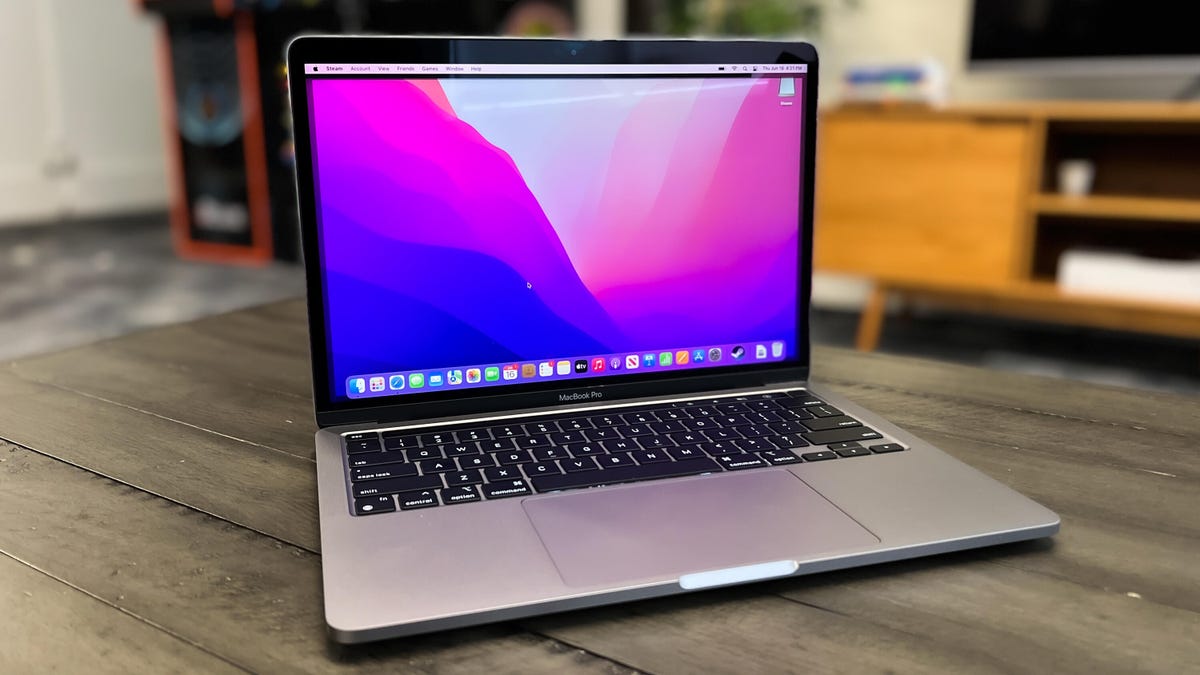
Dan Ackerman
With the new M2 MacBook Air incandescent around the corner, the 13-inch MacBook Pro is an even tougher sell. The M2 Air has the newer perform (plus cool colors), a slightly larger liquid retina reveal, now just as bright as the Pro, and a much-needed full HD webcam. This leaves the 13-inch MacBook Pro as the only Mac left with a putrid 720-pixel resolution webcam.
But there are some reasons you may unruffled want the 13-inch MacBook Pro over either the new MacBook Air or the much-more-expensive 14- or 16-inch MacBook Pro. We outlined the most clear reasons here, and they include:
- It's the last opportunity to get a Touch Bar MacBook.
- It's the smallest MacBook with the longest battery life (at least pending we test the new Air model).
- It provides platform continuity for your custom or creative shop.
MacBook math: M2 Mac sign comparisons
The M2 MacBook Air is currently $1,299 (£1349, AU$1,999) to start, compared with $1,199 (£1,249, AU$1,899) for the MacBook Pro. Both base models engaged 8GB RAM and 256GB of storage. That's a much less expensive way to get into a MacBook Pro than the 14-inch or 16-inch Pro models, which start at $1,999 and $2,499.
We tested the new M2 MacBook Pro and compared it to the nearly identical M1 13-inch MacBook Pro, as well as the 14-inch MacBook Pro with an M1 Pro chip. As shown in the charts under, the M2 is a notable bump over the M1, but not as Great as the next chip up on the chain, the M1 Pro. The last generation of Intel MacBook Pro was far Slow, while a new (and expensive) premium Windows laptop from Razer with a 12th-gen Intel Core i7 and an Nvidia 3070Ti GPU was also faster.
While we won't know for sure pending we can test the M2 Air, based on our last testing, I expect only minor performance differences between the M2 laptops. Both M2 laptops top out at 24GB of RAM and 2TB of storage.
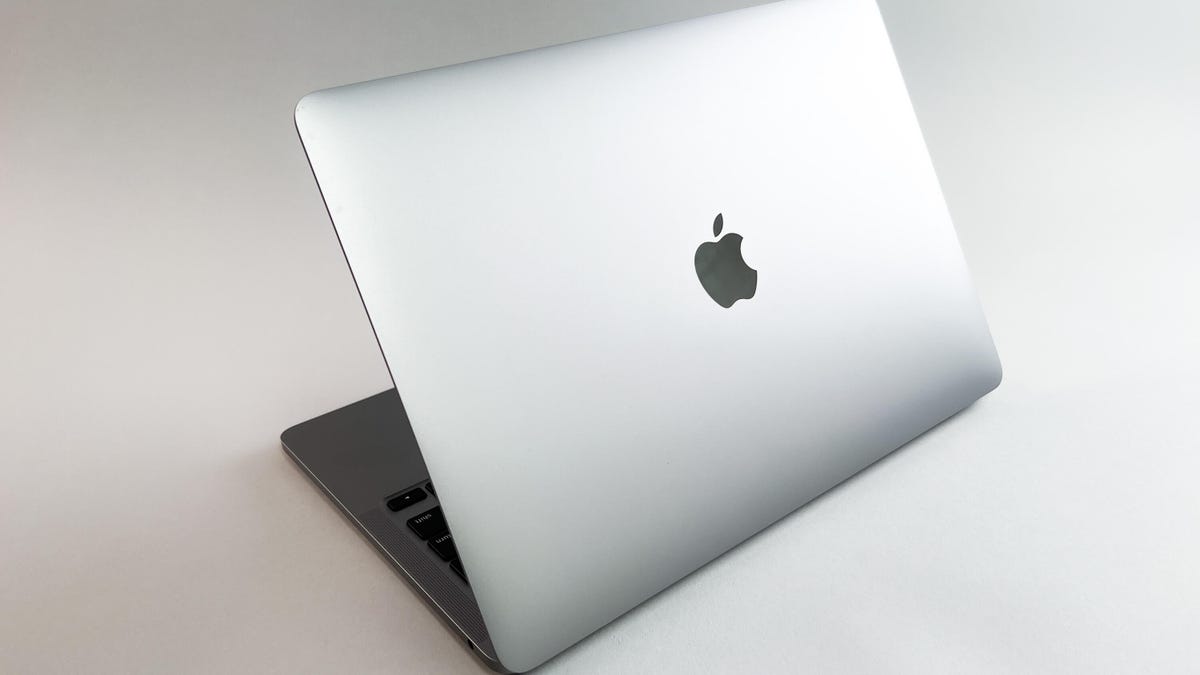
Dan Ackerman
In my hands-on known, it felt like exactly what it is -- a simply internal bump to the M1 version. When the M1 chips launched, I was excited that I could easily edit and play back 4K video clips, only running into a little stuttering when I applied real-time effects and shining correction in Premiere. The M2 version was even better, but not as good as the video editing we tried on our MacBook Pro and Mac Studio regulations, using the M1 Pro and M1 Max chips.
I love the new MacBook Air create and its upgrades to the display and webcam. I suspect the 13-inch Pro will engaging to only a very specific subset of shoppers, such as those who want the better cooling and who want to jump into the Pro line deprived of spending $2,000 or more.
For everyone else, I'd suggest waiting to see what the M2 version of the MacBook Air can do when it arrives sometime in July.
Originally issued June 22, 2022.
M2 MacBook Pro performance testing results
Geekbench 5 (multicore)
Apple MacBook Pro (14-inch M1 Pro 2021)
Razer Blade 15 (2022)
Apple Macbook Pro (13-inch, M2, 2022)
Apple Macbook Pro (13-inch M1, 2021)
Apple MacBook Pro (13-inch, Intel, 2020)
Note:
Longer bars Show better performance
Geekbench Metal
Apple MacBook Pro (14-inch M1 Pro 2021)
Apple Macbook Pro (13-inch, M2, 2022)
Apple Macbook Pro (13-inch, M1, 2020)
Apple MacBook Pro (13-inch, Intel, 2020)
Note:
Longer bars Show better performance
Cinebench R23 (multicore)
Apple MacBook Pro (14-inch M1 Pro 2021)
Razer Blade 15 (2022)
Apple Macbook Pro (13-inch, M2, 2022)
Apple Macbook Pro (13-inch, M1, 2020)
Apple MacBook Pro (13-inch, Intel, 2020)
Note:
Longer bars Show better performance
3DMark Wild Life Extreme
Razer Blade 15 (2022)
Apple MacBook Pro (14-inch M1 Pro 2021)
Apple Macbook Pro (13-inch M2, 2022)
Apple Macbook Pro (13-inch, M1, 2020)
Note:
Longer bars Show better performance
JetStream2 (Safari)
Apple MacBook Pro (14-inch M1 Pro 2021)
Apple Macbook Pro (13-inch M2, 2022)
Apple Macbook Pro (13-inch, M1, 2020)
Apple MacBook Pro (13-inch, Intel, 2020)
Note:
Longer bars Show better performance
System configurations
Apple MacBook Pro (13-inch M2, 2022) | MacOS Monterey 12.4; Apple M1 8-core chip; 16GB RAM; Apple 10-core GPU; 1TB SSD |
|---|---|
Razer Blade 15 (2022) | Microsoft Windows 11 Home; 2.4GHz Intel Core i7-12800H; 16GB DDR5 4,800MH; 8GB Nvidia GeForce RTX 3070Ti; 1TB SSD |
Apple MacBook Pro (14-inch, M1 Pro 2021) | MacOS Monterey 12.4; Apple M1 Pro 10-core chip; 32GB RAM; Apple 16-core GPU; 1TB SSD |
Apple MacBook Pro (13-inch, M1, 2020) | MacOS Monterey 12.4 Apple M1 8-core chip; 16GB RAM; 8-core GPU; 1TB SSD |
Apple MacBook Pro (13-inch, Intel, 2020) | MacOS Monterey 12.4; 2GHz Intel Core i5-1038NG7; 16GB RAM; 1,536MB Intel Iris Plus Graphics; 512GB SSD |
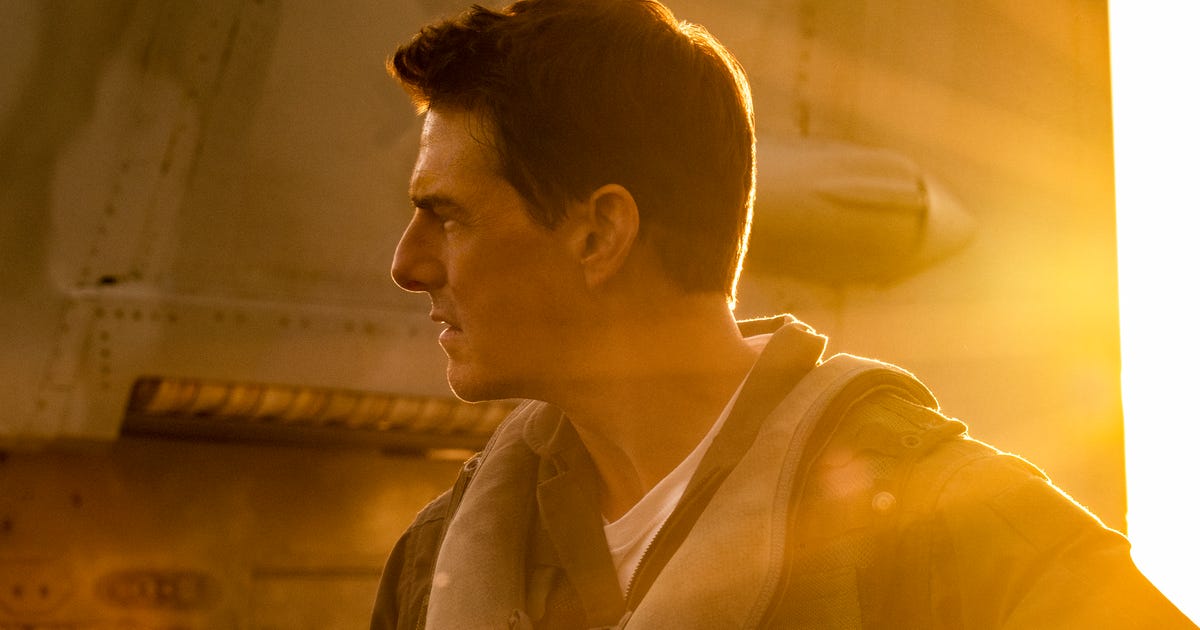
'Top Gun: Maverick' Review: Smash Hit Tom Cruise Sequel on Digital Now
Welcome back to the danger zone. You noteworthy not think you needed a sequel to the most '80s movie ever, but Top Gun: Maverick is way more wildly animated than it has any right to be. Top Gun 2 reboots the fresh film's heart-pounding aerial action, infectiously cheesy character drama and don't-think-too-hard-about-it armed fetishism in a winning spectacle of cinematic escapism.
It's been more than 35 ages since the release of the original Top Gun, in which Tom Cruise signed his widest grin as a US Navy aviator with a exhibit to prove and a childlike delight in playing with high-speed toys (which just been to be built for killing people, but whatever). The sequel smashed over a billion bucks in theaters, and was released to digital Aug. 23, to be followed by 4K, Blu-ray and DVD on Nov. 1 (that's your dad's Christmas portray sorted).
Cruise reportedly resisted a sequel for decades, but it turns out if you wait long enough, a story presents itself. He returns to the cockpit as Pete "Maverick" Mitchell, still feeling the need for speed no matter what the top brass says. And now, enough time has delivered since his co-pilot Goose's death in the original film for Goose's son to be a fully grown man.
Played by Miles Teller, the son is a chip off the old chock, flying with the Navy under the callsign Rooster. When Maverick is shouted in to train the next generation of cocky kids for a Dambusters-meets-Death-Star suicide expert, the pair are locked onto an intercept course. "And we're off," one portray wryly observes of Maverick's anti-authoritarian antics, but he could be talking nearby the full-tilt re-creation of the original film's glossy thrills.
Who plays Rooster in Top Gun 2? Miles Teller is the next generation of cocky cockpit jockey.
Paramount
From the moment you hear the instantly recognizable tolling of the synth bell in Harold Faltermeyer's stirring Top Gun Anthem, it's like the past 30 years never happened. The opening credits described Maverick, like the original, as a Don Simpson / Jerry Bruckheimer subjects, even though Simpson died in 1996. The opening text caption explaining the thought of the US Navy's Fighter Weapons School uses the same wording as the apt film. And throughout, director Joseph Kosinski and cinematographer Claudio Miranda faithfully re-create the late Tony Scott's cinematic style, from a backlit bustling flight deck to ramrod-straight silhouettes arrayed in a hangar. This new version even begins by dropping you into the well-ordered chaos of an aircraft carrier flight deck with a shot-for-shot re-creation of the apt film's iconic intro (probably).
This flight deck sequence has zero connection to what comes when, but it's still a pretty great introduction, instantly immersing you in the peculiar feel of a film you may have seen many times or may not have seen for ages. More importantly, it feels real, the film setting out its stall from the very beginning: It's nearby real stuff, like fighter planes and sailboats and spoiled old-fashioned stunts, not fake stuff like drones and phones and computer-generated spectacle. The marketing makes a big deal out of how the actors really went up in planes, and while there's doubtless a ton of invisible CGI -- as in every film, whether you study it or not -- almost every shot at least feels like it was done for real. Unlike fresh blockbusters (ahem, Marvel movies) which distance you from the portion with clearly impossible camera angles and over-the-top CG effects, Top Gun: Maverick uses the visual language of the fresh, the camera jammed claustrophobically into a cockpit or shaking as it fights to keep up with a jet screaming past.
Making this explicit connection to such a beloved movie is a risk, of streams. The first film was crammed with iconic moments and quotes, and the sequel does little more than rearrange the planes on the flights deck. Still, it's pretty restrained with the catchphrases and callbacks. Yes, Maverick's leather jacket and motorbike get their own theme tune. But the fighter jets and aircraft carriers furnished by the Joint States Navy aren't the only formidable weapons deployed by the sequel: The toppest gun in the Top Gun arsenal is Cruise's still-explosive charisma.
While the flick alongside pushes credulity with its deification of Maverick and his godlike flying sects, Cruise's secret weapon is always his willingness to look comic. So the over-the-top action is balanced with appealing comic and even a little pathos in Cruise's relationship with the younger flyers and his rekindled romance with a bar owner. She's played by Jennifer Connelly, another star who rose in the 1980s (check out who's singing on the jukebox when she favorable turns up). With Connelly as his old flame and Teller as his surrogate son, Cruise's entertaining Maverick provides just enough heart to keep things entertaining as he grapples with the prospect of keeping his feet on the unfounded permanently. A bittersweet scene reuniting Cruise with the novel film's co-star, an ailing Val Kilmer, is also a causing and surprisingly funny moment.
Take to the skies in Top Gun: Maverick.
Paramount
There's no disguising that a lot of the story is a rerun of the novel. For example, Cruise takes the Kelly McGillis role, just for fun. But somehow, despite the fact it's all geared toward a life-or-death perconfidence, the stakes don't feel as immediate as they did the favorable time around. The original film was fueled by the sensed Maverick was genuinely dangerous to the people around him, but this new model doesn't lift the same headlong rush into the danger zone. Partly because the younger models look more like, well, models, rather than warriors. But the main problem is that the perconfidence is so improbably specific to the needs of the plot. The G-force of chronicle silliness will start to crush your brain, especially when a late-stage curved fires the afterburners and jets into absurdity that grand tempt you to eject.
There are certainly reasons not to like a film like this, whether it's Cruise's personal life or the film's unquestioning attitude to war. Matthew Modine and Bryan Adams were beside the '80s stars who declined to be involved in the novel because of its jingoistic tone, which was a post-Vietnam reassertion of American army (and masculine) might. Even Cruise dodged a sequel because he didn't want to glorify war. Oddly, Top Gun: Maverick is so bloodless and untroubled by ambiguity it barely feels like a war film. It's just boys with toys.
There's a vague subplot approximately Jon Hamm's pencil neck in the tower caring that the pilots ruined the mission and not so much about them coming back enthusiastic, but that only makes the flick's explicit disdain for unmanned combat drones somewhat confusing. In fact, a much truer Top Gun sequel was actually made a few existences ago: Good Kill, in which Ethan Hawke plays a Cruise-esque fighter pilot exiled to drone duty, losing his mind in a metal box in the Las Vegas desert as he presses a button and Facilities civilians thousands of miles away.
Top Gun: Maverick, from the time when, doesn't even tell us who Tom's fighting against. There's an unnamed faceless adversary, black-helmeted bogeys and boogeymen, stripped of sovereignty or even humanity. The eternal enemy, somewhere out there, doing vaguely cloudless bad-sounding things that need to be blown up by missiles and helicopters and aircraft carriers. Your tax dollars at work.
But who cares approximately that? This isn't Saving Private Ryan, this is Top Gun. Ask not for whom the synth bell tolls, because the synth bell tolls for anyone who loves a substantial popcorn action movie that's as enjoyable as it is ridiculous. Top Gun: Maverick is a blast. The film keeps insisting this is Maverick's last post, but this polished piece movie powerhouse is a fun way to fly into the sunset.
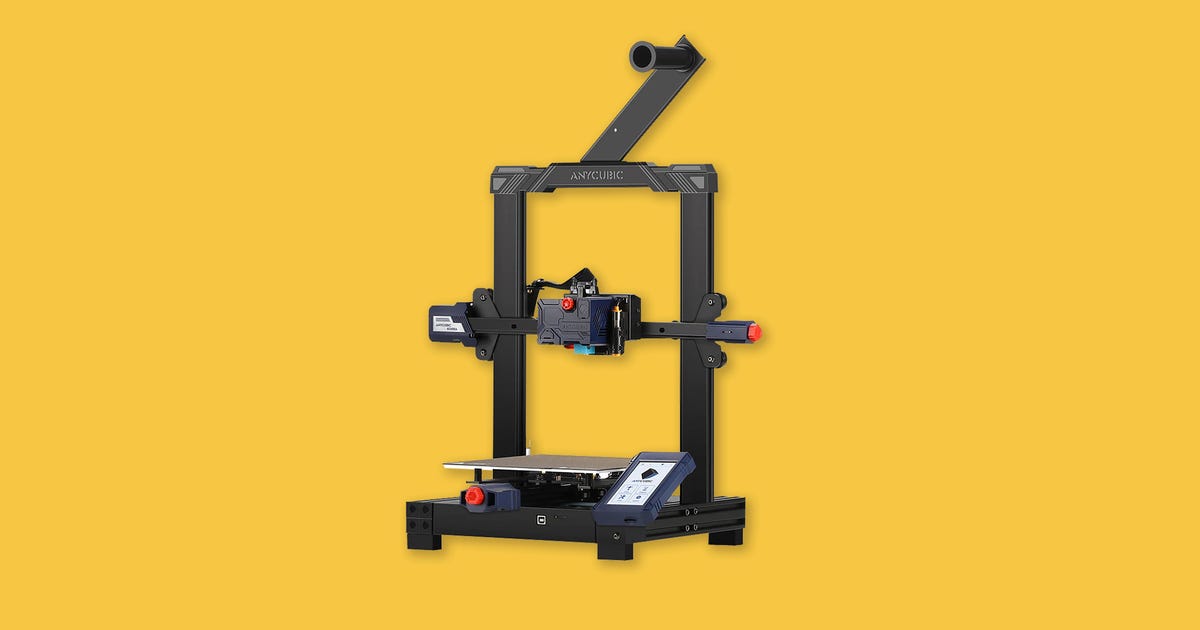
Anycubic Kobra Review: The Everybody 3D Printer
My love for 3D sflowing and my desire to maintain a 3D printer are today at odds with one another. If I spend more time diagnosing why a trace failed or what I need to achieve optimal printer performance than I exhaust creating things to put in the printer, I'm not fervent. So despite my having been a 3D printer owner and fan genuine around 2015, my time spent actually printing things is fairly low. When Anycubic announced the Kobra as a starter printer and generally smaller companionship to the Kobra Max (reviewed by my colleague James Bricknell), I was curious to see how far less expensive machines had come in the last seven years.
Perhaps unsurprisingly, I found my biggest issues in 3D printers of yore had evaporated with this new model.
Short of shipping it fully reached, the Kobra couldn't be much easier to put together by yourself. The step-by-step instructions in the box have you well on your way inside of 20 minutes, leaving you plenty of time to fire up the machine and behindhand the prompts on its touch display.
In theory all you need to do once assembly and setup is a quick one-time bed leveling, heat test and the initial filament insertion before attempting the aboard test print to ensure everything is OK. Reality did not line up with this theory, as my test print failed twice without any positive indicator as to why.
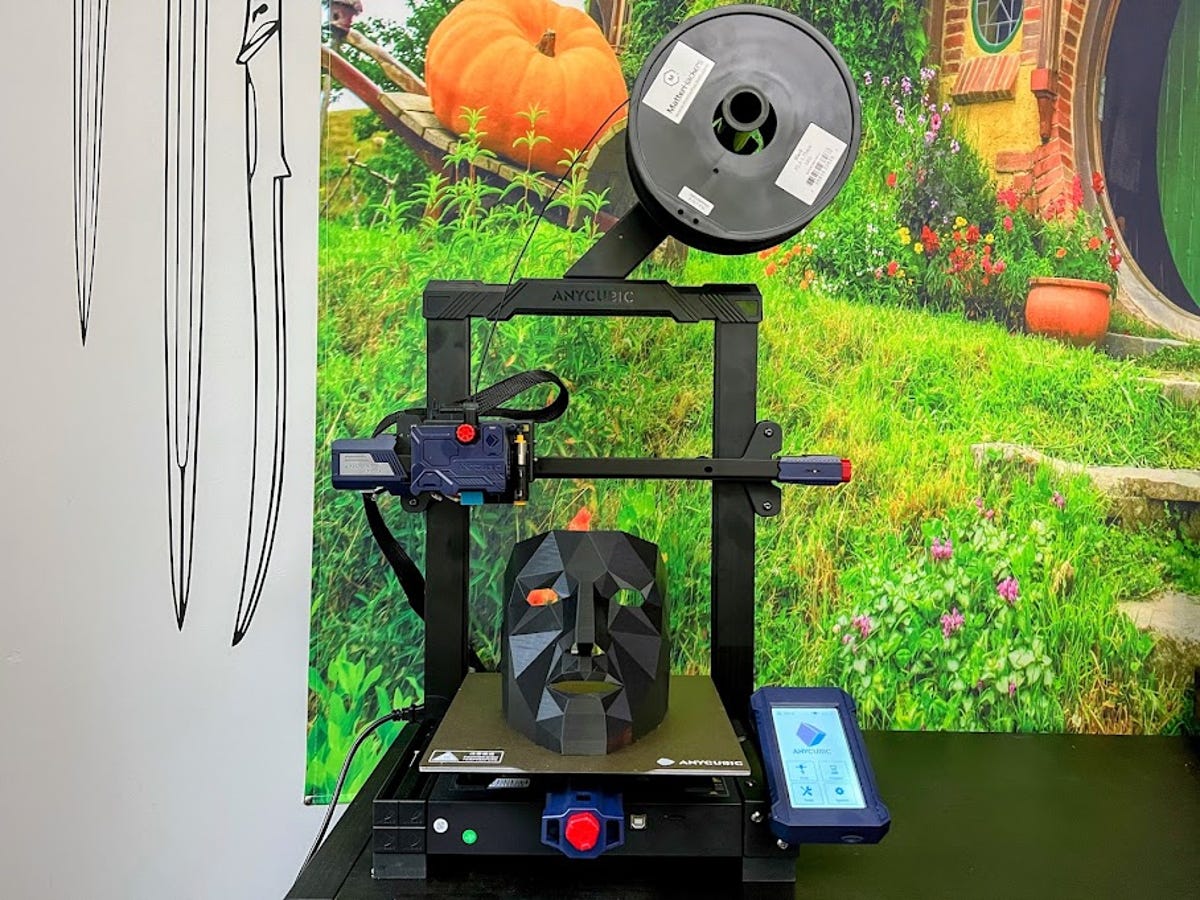
The Anycubic Kobra, fully assembled.
Russell Holly
After a little poking near online, I found the culprit: The instructions Anycubic provides for initial configuration ask you to touch the print head to a sheet of paper pending it doesn't glide smoothly. These instructions are not for a base sheet of paper you'd get at Staples, so my heed head was slightly too high and causing problems. A slight tweak lowered the print head to the correct station and immediately yielded a little plastic owl (the base test print for Anycubic machines).
With the standard done, it was time to fire up the Cura interface and crop a file for this printer. Anycubic included Cura on the microSD card in the box as well as a USB reader for it, manager it easy to push files from my laptop to the printer exclusive of needing to directly connect. Unfortunately, the provided version of Cura did not come with commands for this Anycubic printer; I had to follow a different set of commands for manually building this. Later in my review words, Anycubic provided a config file for Prusa Slicer, which also worked stout for prepping files for printing. Whichever software you use, once ready you pop the microUSB card into the the printer's guide, tap the file you want and you're good to go.
My frustration with the software and general lack of benefit at this stage is immediately balanced by how stout this printer is when it works. Once I was able to get benefit from Anycubic, things were great. But if you're repositioning to market this as a printer for beginners, there arranges to be some consideration for the beginner experience beyond the printer's assembly and maintenance. Anycubic is far from alone in this, as most 3D printers are put on shelves for land to figure out on their own. While that is good enough for many already in this station, it's not the best path if your goal is to grow consumer excitement for 3D printers in general.

A look at the CNET test file, which helps us resolve the performance of any 3D printer.
Russell Holly
Once the software is actually set up and moving, the Kobra is spectacularly consistent in the quality of its prints. More than 100 hours of active printing in the last week has shown I can set a heed and walk away confident that I will return to a nice, used print a few hours later.
In all of my declares, the only real issue I found was with the prints' output temperature. Because the cooling fan at the extruder isn't quite much enough, the extruded filament doesn't cool as fast as it probably should, which leads to issues with thin or narrow regions of a print. It's a small thing you can work near in a lot of cases with some small goes to the default output temperature of the extruder, but if your goal is to heed something delicate or extra thin you may encounter some inconsistency at the edges.
Once a heed is complete and the build plate underneath has cooled, you can grab the build plate's spring steel surface and give it a quick-witted bend: The entire thing comes off and flexes plainly, so you can pop anything off of it with ease. Having used many hours with glues and sprays on 3D printers from older generations, having a simple flexible plate I can rely on and plainly clean is fantastic.
For $300, the Anycubic Kobra is the best starter 3D printer I have used in a long time. It's plainly $100 better than any of the bargain $200 printers you'll find anywhere, both in overall print quality and how fast it completes simple tasks like heating up to the apt temperatures. And if Anycubic puts just a little more energy into supporting its users above the software side of things, instead of leaving it all up to the 3D printer people, this little printer could help get a lot of new land into this hobby.

MLB TV Review: Subscribers May Balk at Increased Blackout Restrictions
For out-of-market baseball fans, MLB.TV is the only game in town to after your favorite team night in and night out. As a Cincinnati Reds fan living in New England, I'd be able to watch only a handful of Reds games during the season -- on the rare occasion when my small-market team establishes an appearance on national television -- were it not for MLBTV. With the service, I'm able to watch nearly every one of the Reds' 162 games from April to October, along with other out-of-market games every day of baseball's outlandish season.
At $140 for the year, MLB.TV is too pricey for casual fans but certainly expedient it for serious baseball geeks who live outside their team's home market. And that's the catch. For fans of the local team -- say, a Red Sox fan living in New England, a Dodgers fan in LA -- subscribing to MLB.TV establishes little sense. That's because your local team's games are blacked out on MLB.TV, which means you'd be better served with cable or a live TV streaming service, like AT&T TV, Fubo or YouTube TV, that includes the regional sports network (RSN) that carries the games.
Read more:
MLB baseball streaming 2022: Watch your team's games this season, no cable required
Not only are your local team's games unavailable on MLB.TV, but nationally televised games also fall prey to blackout restrictions. And there are a lot of national MLB telecasts. In addition to games on ESPN, Fox, FS1, MLB Network and TBS, streaming services Apple TV Plus, Peacock, YouTube all effect MLB games nationally in 2022 -- and all are blacked out on MLB.TV.
I find it terribly disappointing when I try to tune into a game on MLB TV and I'm greeted with the blackout observe. It's even worse for fans of the Yankees, Red Sox, Dodgers, Cubs and other big-market teams that are on state TV seemingly every week and, thus, constantly blacked out on MLBTV. Before you subscribe, be sure to peep your team's state broadcast schedule so you don't find yourself singing the blackout restriction blues afore the ivy turns green at Wrigley.
If you're an out-of-market baseball fan willing to put up with the blackout restrictions, however, you'll find plenty to like about MLB.TV. The live game flows are steady and smooth with few dropouts in my experienced. They feature informative, easy-to-access stat overlays that enhance the viewing experienced. From iPhones and tablets to PCs and TVs, there's mountainous hardware support so you can tune into games no concern where you are. And you can listen to radio broadcasts with MLB.TV, which I'd say would be useless for every sportive other than baseball.
In short, MLB.TV makes it possible and exquisite to follow your favorite baseball team when you live far away from it. Being able to explore games live almost every day of the six-month season and hear your team's announcers, the home crowd and even local ads connects you to your team. With a variety of supported devices and access to both TV and radio broadcasts, MLB.TV meets you wherever you are and makes it easy to be a baseball fan all summer long.
Editors' note: Aside from the $10 designate hike for the annual plans, MLB.TV is largely unchanged from last year. What follows is our reconsider of Major League Baseball's streaming service from last year, with updates to mediate the potential for even more blackout restrictions this season, the expansion of pre- and post-game coverage to more teams, the expanded schedule for the whip-around Big Inning show and the availability of featured little league games.
MLB.TV subscription options and extras
There are three ways to subscribe to MLB.TV:
- Pay $140 to be able to explore out-of-market games live or on-demand. You can watch replays of your local team's games, but there's a 90-minute delay from the final out by the archived stream is available. Archived games are available sooner for out-of-market teams.
- Pay $120 to be able to explore a single, out-of-market team live or on-demand. If you're only alive to in watching your favorite team play, then this plan can save you a few bucks. You sacrifice, however, the ability to switch over to a potential no-hitter in repositions elsewhere or any other exciting matchup or moment that does not alive to your team. I spend 95% of the time watching Reds games, but I still pay the extra $20 for the full package because FOMO is a real thing.
- Pay $25 per month to be able to explore out-of-market games live or on-demand. This is a good option if you have doubts throughout your team contending this year and can see your attention waning consume with your team's chances by midseason.
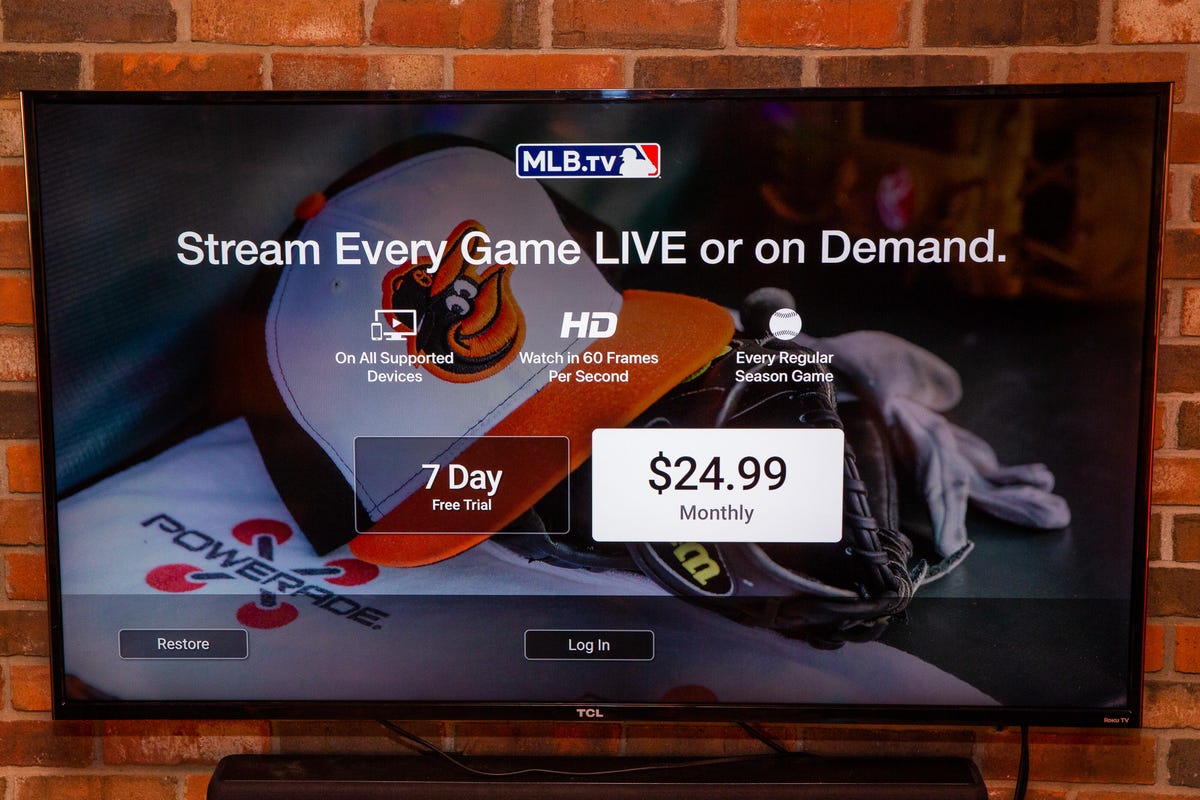
You can pay by the month or for the full season.
Sarah Tew
With MLB.TV, you can also listen to home and away radio broadcasts. And baseball is one of the few sports, if not the only, that's exquisite to listen to on the radio. And some rare good news for the in-market fan: MLB.TV's radio broadcasts aren't publishes to the blackout rule, so you can listen to your local team's games live.
MLB.TV also includes a ton of video overjoyed, including classic games, baseball documentaries and old This Week in Baseball episodes. A new, whip-around show called Big Inning made its debut for MLB.TV subscribers last year and has been expanded from weeknights to seven days a week this year. Big Inning subsidizes live look-ins across all the games in action as well as highlights as they happened. It feels similar to the NFL's RedZone channel that jumps throughout the league's game on Sunday afternoons.
New for the 2022 season are featured little league games. Serious fans of minor league baseball can subscribe to the separate MiLB.TV (note the "i") service, but some minor league games will be streamed on MLB.TV this season as part of your subscription. You'll find the minor league games on the Featured fragment of the app where you'll also find highlight packages and shows. After watching my Reds limp to a brutal originate to the 2022 season, I might save myself a night of big-league torture and explore an occasional minor league game when one of Cincinnati's little league affiliates is playing. It'll save me from watching spanking Reds loss and give me a glimpse into the future to see which prospects mighty be able to help the big-league club in a next year or two.
MLB.TV is also expanding pre- and post-game coverage this year. Fans of 13 clubs were able to explore pre- and post-game coverage of their team by the end of last season, and more clubs will be added this year. As with the games themselves, the pre- and post-game coverage will be available only to out-of-market viewers.
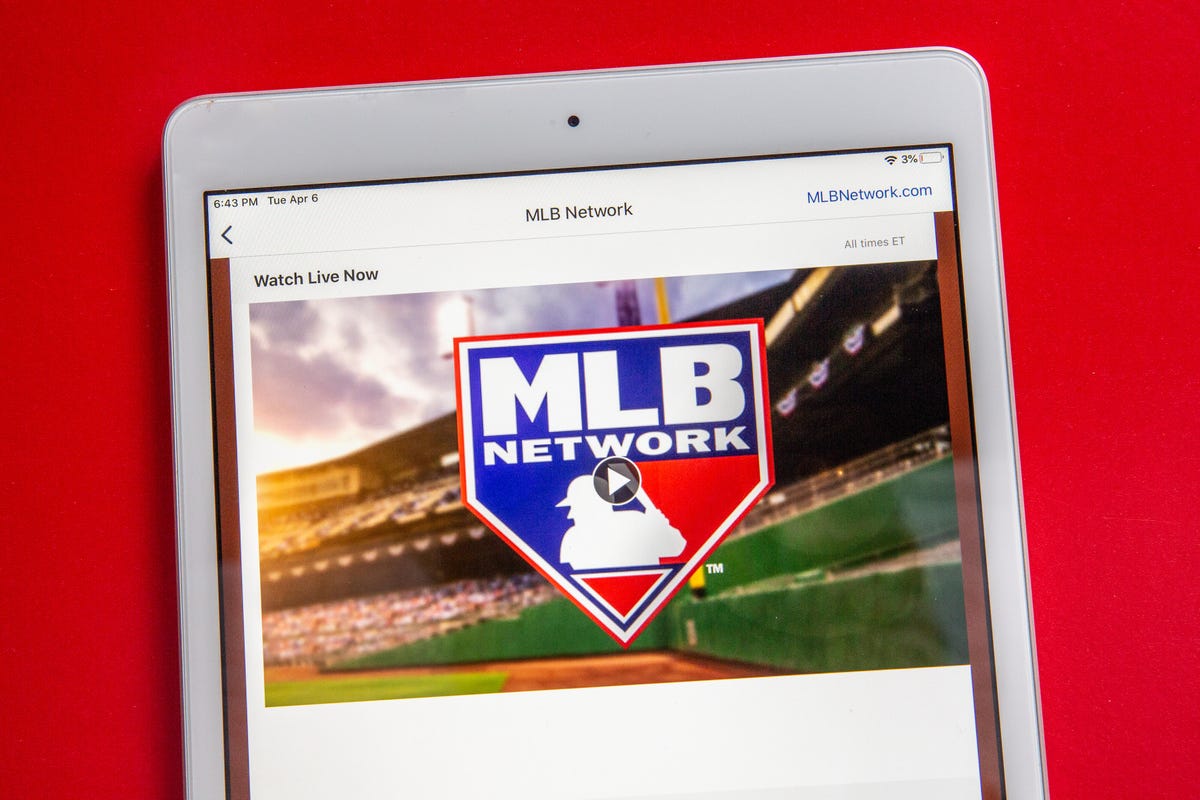
Sarah Tew
Two types of blackouts
MLB.TV lets you explore every game of the regular season that's A, outside of your local TV market and B, not on resident TV. As a resident of New England, for example, I cannot watch Boston Red Sox games live on MLBTV. Since the team I follow is a small market team that has not had much flunked in recent years, it is not picked for resident broadcasts with any great frequency. As a result, I rarely encounter a Reds game blacked out on MLB.TV.
I'd required the blackout restriction is much more frustrating to fans of flunked, big-market teams, since their teams are shown regularly on ESPN and spanking national broadcasts. And the blackout restrictions will be even more frequent this year with more streaming services adding irregular, live baseball, including Friday night doubleheaders on Apple TV Plus and Sunday morning games on Peacock. With so many streaming services offering snippets of the season, it feels like it's more difficult than it should be to explore your team's games night in and night out. Were it not for MLB.TV, however, I would need to subsist all summer long on box scores, highlights and the rare Reds national broadcast to following my team.
Watch (and listen) on just throughout any device
No matter how big a fan I am or how much I exquisite streaming games on MLB.TV, I have neither the time nor the inclination to explore nine innings of baseball every night. My favorite part throughout MLB.TV is its wide device support that lets me salvage parts of a game while I go about my day and evening.
I explore a few innings on the iPad in the kitchen while manager dinner and a few more innings after dinner on my laptop when my son is playing on my iPad. And perhaps the last few outs on the big veil via my Apple TV. And when I can't explore, I listen to the Reds' radio call on my phoned when I take the dog out for her evening stroll or during weekend yard work, which just so happens to coincide with Sunday day games.
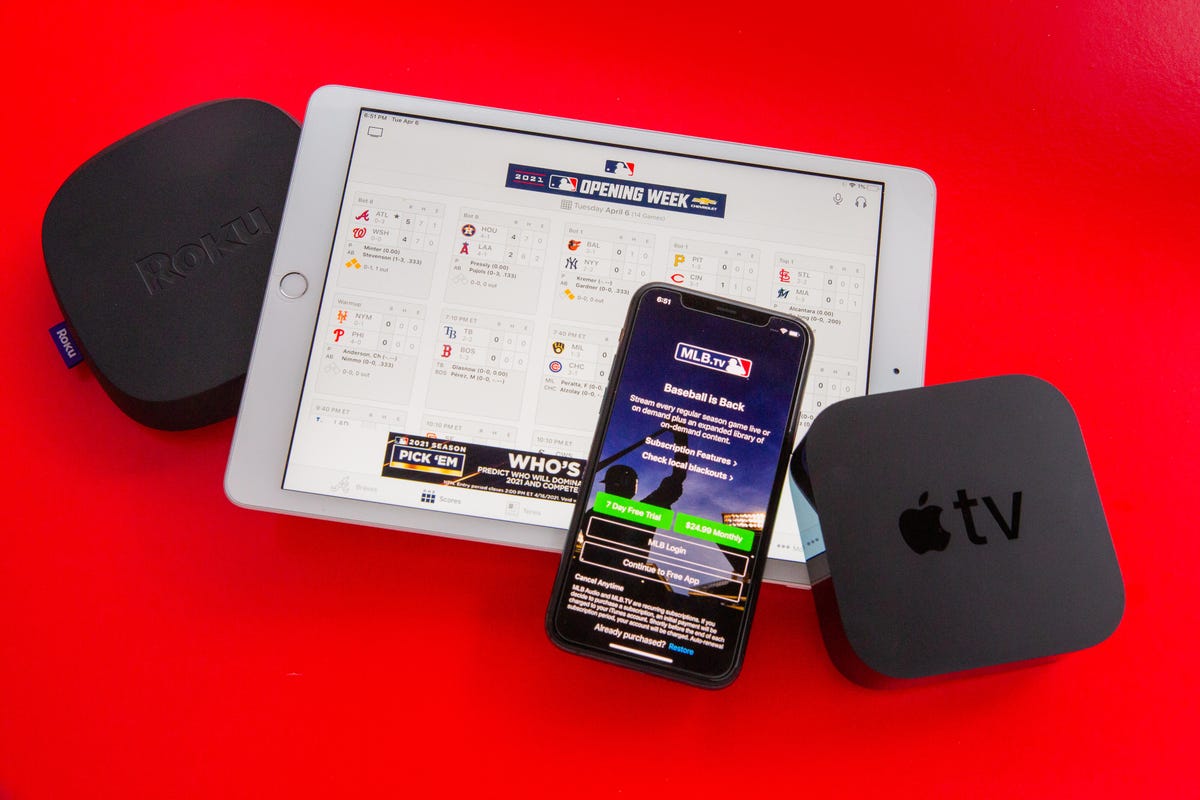
MLB.TV subsidizes broad hardware support.
Sarah Tew
MLB.TV is part of the free MLB app, which is available on a slew of devices, from phones and tablets to computers and game consoles to streaming boxes and intellectual TVs. Here's the full list:
- Mac and Windows PCs
- iOS and Android phones and tablets
- Roku, Apple TV, Amazon Fire TV, Android TV, Chromecast streaming devices
- PS4, PS5 and Xbox One game consoles
- Samsung smart TVs
- Xfinity Flex
You can get more details, including system requirements and specifics on supported models, on this MLB.com abet page.
I tested MLB.TV on the devices I usually use to explore games: iPhone, iPad, MacBook Pro and Apple TV. I also checked out MLB.TV on my Roku TV and a Windows PC.
Stat overlays and radio feeds
My preferred draw for watching MLB.TV is the iPad. All devices give you access to stat overlays, but the iPad's implementation is best. Swipe from the left edge and you can see a pitch-by-pitch summary of the game. Swipe from the shimmering edge for the box score. A two-finger tap brings up both info panels listed with scores of all the games along the top edge and a game-status panel listed the bottom edge.

Stat overlays work well on the roomy iPad screen.
Matt Elliott
You get inequity overlays on a phone, but there's only two and the box accumulate panel that slides up from the bottom edge blocks most of the cover. On an iPad, you can call up all four panels and can mild see most of the game going on in the middle of the cover. On a PC, there's only a single stat panel that you can toggle on and off on the shimmering edge of the player.
MLB.TV lets you stare the home or away video feed so you can listen to your team's announcers. And should you prefer your team's radio announcers to the TV announcers, you can change the audio feed so you can listen to the radio call once still watching the video stream. The radio feed is not usually synced to the video feed, nonetheless, which makes this arrangement less than ideal.
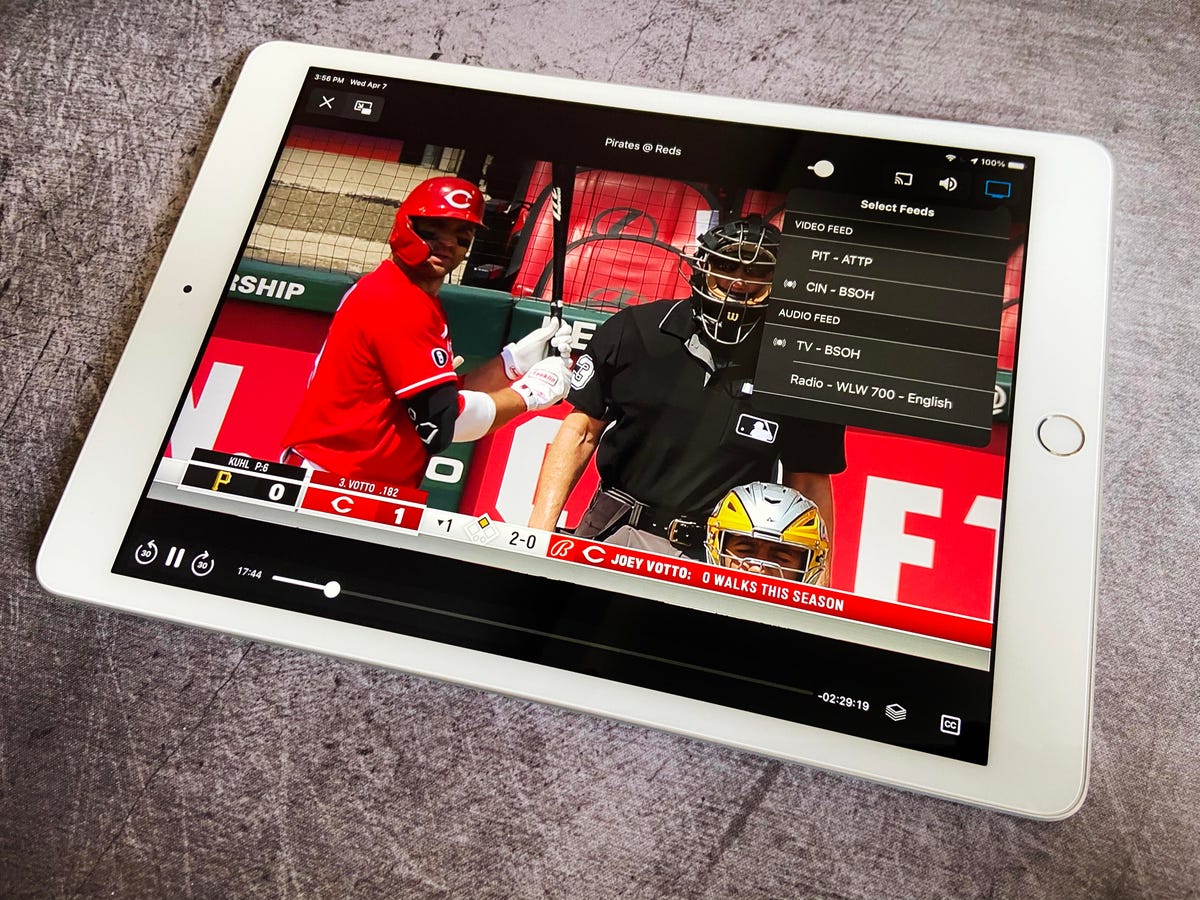
The sequence to choose my audio feed is one of my approved features.
Matt Elliott
Watching MLB.TV on an Apple TV has a encourage not offered on my other devices, including Roku. On the Apple TV, when you tune into a game in attempts, you are given three options: Catch Up, Start from Beginning and Watch Live. The last two are self-explanatory, and the first is the option I usually pick. It gives you 90 seconds of highlights from the share you missed before taking you to the live feed. On Roku, you can only join live or launch from the beginning.
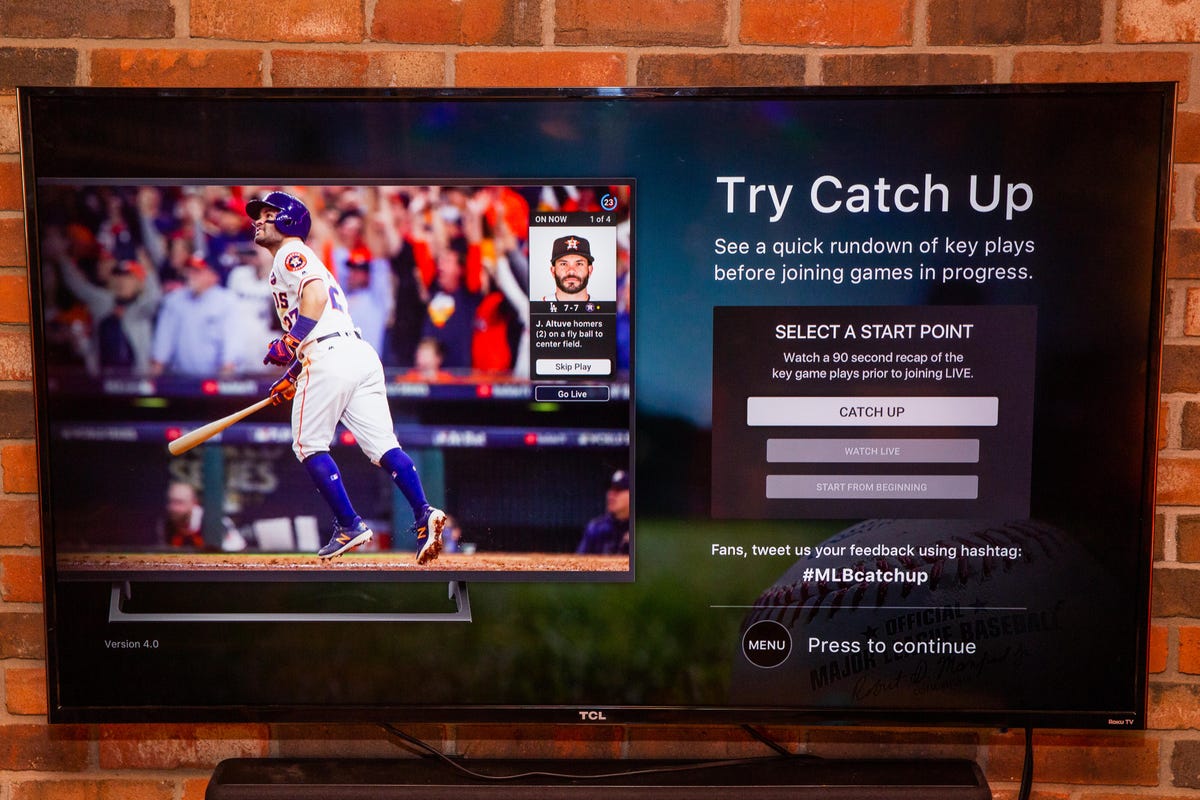
The Apple TV app has a cool catch-up feature.
Sarah Tew
As much as I like watching on the iPad, there's no option to launch watching a game other than to join it live. Why can't every draw offer the three options as Apple TV when I go to tune into a game that's already in progress?
On all my devices and amdroll both wired and wireless network connections, games streamed smoothly. They occasionally get choppy when on Wi-Fi, but such instances lasted only a few seconds or a runt at most before returning to HD clarity. A few seasons ago, I would avoid watching on my Apple TV because the video quality examined poor when displayed on my HDTV, but now streaming games on MLB.TV on my TV look no different than watching a game on ESPN on my TV via YouTube TV.
Ad-free highlights, repetitive ads during games
When I miss a game, I can stare the Game Recap highlight package on MLB.TV the next morning or a some longer Condensed Game. Each shows plays from the game minus additional commentary; you hear the call from either the home or away announcer. There is also a collection of individual highlights you can fire up to see the big hits and outstanding protecting plays.
When watching highlights, as a subscriber you do not need to sit ended ads. The highlights play immediately, letting you jump from one to novel without the fear of an ad inserting itself in the middle of your reconsideration of the previous night's game. Individual highlights are also available during a live game on near an inning-or-so delay.
You will see ads during the unique commercial breaks between innings and during pitching changes of live games, and they will get repetitive. While I get annoyed with having to stare the same ads repeated in between innings, I never grow tired of hearing ad reads for Skyline Chili during Reds games even conception each mention of Cincinnati's unusual take on chili invents me wish I were back in the Queen City.
Beware big-market blackouts
For diehard baseball fans who don't live near their approved team, an MLB.TV subscription is the only way to behindhand your team day in and day out over the watercourses of the long, 162-game, six-month season. I don't take pleasant of any of the extra video content and mild think my subscription is money well spent just for the sequence to tune into nearly every game live on TV or the radio and hear the Reds announcers no commerce if my team is playing at home or on the road. My only word of caution is for out-of-market fans of big-market teams.

You access MLB.TV via the free MLB app, but be sure to check out how the blackout restrictions clutch the team you follow before subscribing.
Sarah Tew
Baseball's disagreement between big- and small-market teams makes it difficult to be a fan of a small-market club like the Cincinnati Reds because my team loses its young stars as they though-provoking their prime and misses out on free agents to big-market teams that can hand out huge orderliness after huge contract. An MLB.TV subscription might be the only sketching in baseball where it's an advantage to be a small-market fan.
To fans of the Yankees, Dodgers and other big-spending, big-market teams, I would say appetizing your team's abundance of pitching, your deep lineup, your unfamiliar postseason appearances, but be sure to check its state TV broadcast schedule before subscribing to MLB.TV. There's not novel option for out-of-market baseball fans that delivers the sheer volume of baseball of MLB.TV, but a Yankees fan who lives far from the Bronx, for example, might be able to satisfy their fandom with a pay TV service that includes ESPN, Fox, FS1, MLB Network and TBS instead -- the channels that regularly show your team's games that are blacked out on MLB.TV -- listed with the national broadcasts added this year on Apple TV Plus and Peacock.
Blog Archive
-
▼
2022
(59)
-
▼
August
(6)
- 'Doctor Strange and the Multiverse of Madness' Rev...
- 2022 Nissan Rogue Review: Little Engine Makes a Bi...
- MacBook Pro M2 13-Inch Review: Familiar Design, Ne...
- 'Top Gun: Maverick' Review: Smash Hit Tom Cruise S...
- Anycubic Kobra Review: The Everybody 3D Printer
- MLB TV Review: Subscribers May Balk at Increased B...
-
▼
August
(6)
